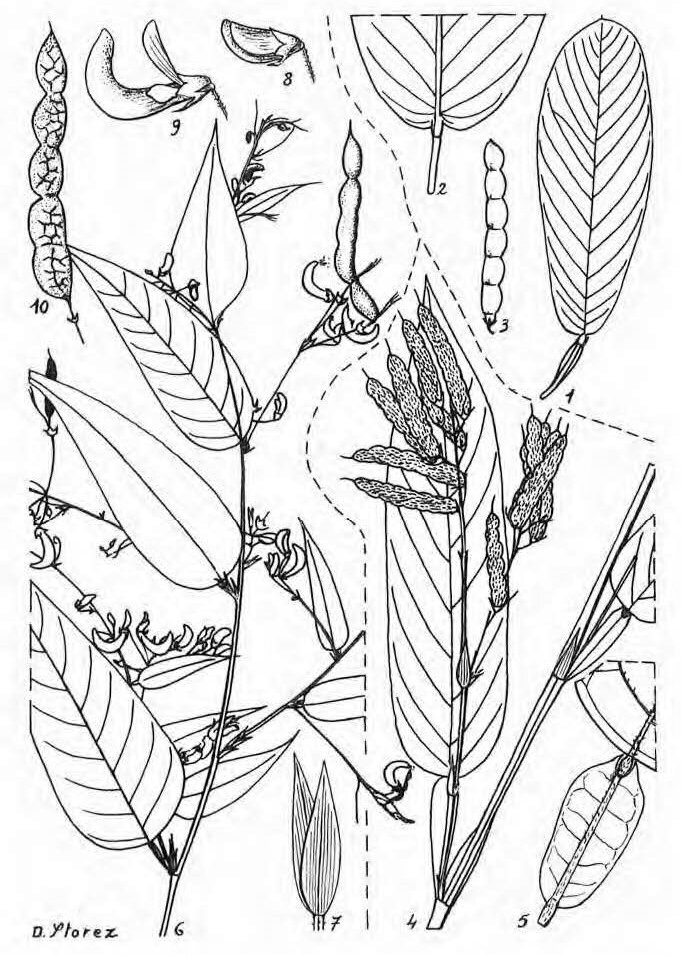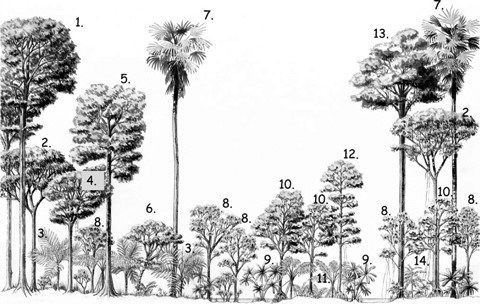The Botanist's Corner
by Angkor Database
Angkor Database 'Botanist's Corner' aspires at furthering the titanic work initiated by Cambodian botanist Pauline Dy Pho

Publication: ADB Special Online Projects
Published: 2021
Author: Angkor Database
Pages: 1
The work of Pauline Dy Phon (1933−2010)
- In 1970, Cambodian botanist Pauline Dy Phon published La végétation du sud-ouest du Cambodge (Annales de la Faculté Sciences de Phnom Penh, 3, 1 – 136; 4, 1 – 59). In 2017, Philip W. Rundel, Professor at University of California Department of Ecology and David John Middleton, Keeper of the Herbarium at Singapore Botanical Gardens, translated and completed her work in their publication The flora of the Bokor Plateau, southeastern Cambodia: a homage to Pauline Dy Phon, including 359 species. Read their article (in Cambodian Journal of Natural History 2017 (1), pp 17 – 37).
- Pauline Dy Phon’s Lexique des arbres forestiers du Cambodge (Lexicon of Cambodia’s Forest Trees)in an abridged, searchable version.
- The previous work completed and expanded the 692 trees and shrubs with vernacular Khmer names listed by Pou Saveros and Bernard Rollet in 1973 (Lexique des arbres et arbustes du Cambodge, BEFEO, Vol. 60, pp 117 – 62). Pauline Dy Phon’s teacher at the Musée d’histoire naturelle, Prof. Jules-Émile Vidal, contributed to the list.
- Pauline Dy Phon’s monumental dictionary, វចនានុក្រមរុក្ខជាតិប្រើប្រាស់ក្នុងប្រទេសកម្ពុជា |Dictionnaire des Plantes utilisées au Cambodge | Dictionary of Plants Used in Cambodia
- In 1981, Pauline Dy Phon published Taxons nouveaux pour la Flore de l’Indochine (New Taxons for the Indochinese Flora)
- In 1994, Pauline Dy Phon co-authored (with ) Vol. 27 of Flore du Cambodge, du Laos et du Vietnam, studying Leguminosae (Fabaceae), Papilionoideae, Desmodieae.
Further Readings
- ASEAN Herbal and Medicinal Plants, collective, 2010, Djakarta.
- ‘Tonle Sap Authority discovers 196 new plants around Tonle Sap Lake, one special species’ (Phnom Penh Post, 22 June 2021)
- In 1790, Portuguese Jesuit missionary Joao de Loureiro (1710−1791) published Flora Cochinchinensis, sistens plantas in regno Cochinchina nascentes : quibus accedunt aliae observatae in Sinensi imperio, Africa orientali, Indiaeque locis variis : omnes dispositae secundum systema sexuale Linnaeanum, a work inspired by his interest in local medicinal plants after spending in 1790. Loureiro’s work was an extension of his interest in local medicinal plants after spending 35 years, mostly as chief mathematician and naturalist, in the service of the King of Cochinchina.
- About the Cambodian evergreen swamp forest, read the article Evergreen swamp forest in Cambodia: floristic composition, ecological characteristics, and conservation status, by Ida Theilade, Lars Schmidt, Phourin Chhang, J. Andrew McDonald
- The Cambodian Journal of Natural History, launched in Phnom Penh in 2008 (a collaboration of Fauna & Flora International and the Royal University Centre for Dioversity Conservation (CBC) is now available online. Read the first issue here.
Herbal Medicine in Cambodia
- Moeun Chhean Nariddh in Khmer Times (30 Apr. 2021) about contemporary use of traditional herbal medicine.
- Access to traditional herbal medicine has seen a revival in Cambodia since 2010, read Bandeth Ros’ (and altri) study The commercialization of traditional medicine in modern Cambodia (2017)
Pascal Medeville’s Notices on Tela Botanica
The author completes the botanical description of each species with the cultural context in which it appears in Cambodian history and culture (in French).
- Kaempferia Harmandiana (ប្រោះស្វា [braoh sva])
- Sugar Palm, Borassus flabellifer (ត្នោត [tnaot])
- Indian goosberry or emblic, Phyllanthus emblica) (កន្ទួតព្រែ [kantuot prey])
- Sacred Fig (Figuier sacré), Ficus religiosa, (ដើមពោធិ៍ [daem po], 菩提树 [pútíshù])
Going greener
- Angkor Center for Conservation of Biodiversity (ACCB)
- Kulen Reforestation by school students (2021) with ADF
- Plantsify Cambodia nurseries and gardening store
- ចំការ ណាគូពេនដា Nakupenda Kampot — permaculture garden in Cambodia
- Kampot Mushroom Farm
Angkor Mushrooms
- Meet the “Gardeners of Angkor”, the team in charge of the flora growing in the temples (Cambodge Mag 2022, in French)
- A few steps from Angkor Wat, in Tropeang Se, the Angkor Nature Observatory (ANO) led by Christophe Guenole offers botanical treks around the Archeological Park.
Mushrooms in Cambodia
Mushroom, the conspicuous umbrella-shaped fruiting body (sporophore) of certain fungi, typically of the order Agaricales in the phylum Basidiomycota but also of some other groups. Popularly, the term mushroom is used to identify the edible sporophores (Enc. Britannica). In Cambodia, mushrooms are often used for medicinal treatments.
- In 2016, a team of Korean researchers led by Jong Kyu Lee publishe A Checklist of Mushrooms of Cambodia [Journal of Forest and Environmental Science, Vol. 33, No. 1, pp. 49 – 65, February, 2017] reviewing “3,950 mushroom specimens collected from the Central Cardamom Protected Forest (CCPF) in Koh Kong province, the Kirirom National Park (KNP) in Kampong Speu province, the Seima Biodiversity Conservation Area (SBCA) in Kratie province, the Mondulkiri Protected Forest (MPF) in Mondulkiri province, the Phnom Bokor National Park (PBNP) in Kampot province, the Western Siem Pang Protected Forest (SPPF) in Stung Treng province, the Ream National Park (RNP) in Sihanoukville province of Cambodia from 2009 to 2014, and then they were identified and classified into 302 species, 165 genera, and 64 families by morphological and genetical characteristics. The mushrooms belongs to Ascomycota were classified into 26 species, 14 genera, and 10 families, while those belongs to Basidiomycota were classified into 276 species, 151 genera, and 54 families, respectively. Among these mushrooms, the most species-rich families are Polyporaceae (26.2%), Marasmiaceae (9.1%), Ganodermataceae (7.7%), Hymenochaetaceae (7.5%), and Mycenaceae (7.1%), and comprised 57.5% of the total specimens identified.”

Profile of evergreen swamp forest showing the characteristic species. Height and length approximately 35×50 m. (1) Shorea guiso, (2) Archidendron clypearia, (3) Areca triandra, (4) Sindora siamensis, (5) Myristica iners, (6) Fagraea racemosa, (7) Livistona saribus, (8) Macaranga triloba, (9) Licuala spinosa, (10) Eugenia albiflora, (11) Cibotium barometz. (12) Litsea sp. (13) Dipterocarpus costatus, (14) Pternandra caerulescens (from Evergreen swamp forest in Cambodia…, op.cit.)
Tags: botanic, fauna and flora, Cambodian forest, wood, heritage conservation, biodiversity, biodiversity conservation, mushrooms
About the Author

Angkor Database
Angkor Database — មូលដ្ឋានទិន្នន័យអង្គរ — 吴哥数据库
All you want to know about Angkor and the Ancient Khmer civilization, how it keeps attracting worldwide attention and permeates modern Cambodia.
Indexed and reviewed books, online documentation, photo and film collections, enriched authors’ biographies, searchable publications.
ជាអ្វីគ្រប់យ៉ាងដែលអ្នកទាំងអស់គ្នាចង់ដឹងអំពីអង្គរ, អរិយធម៌ខ្មែរពីបុរាណ, និងមូលហេតុអ្វីដែលធ្វើឲ្យមានការទាក់ទាញចាប់អារម្មណ៍ពីទូទាំងពិភពលោកបូករួមទាំងប្រទេសកម្ពុជានាសម័យឥឡូវនេះផងដែរ។
Our resources include the on-site Library at Templation Angkor Resort, Siem Reap, Cambodia, with exclusive access for the resort’s guests. Non-staying visitors can ask for a daily pass email hidden; JavaScript is required.
